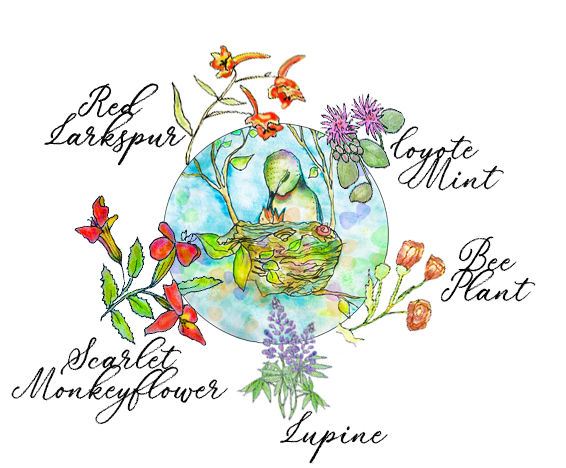“A flash of harmless lightning,
A mist of rainbow dyes,
The burnished sunbeams brightening
From flower to flower he flies.”
John B. Tabb
Hummingbirds are one of the few bird families that may benefit from humans’ presence. As our population increases, more land is used for housing. Mindful homeowners are encouraged to plant species that are beneficial to migrating hummingbirds and butterflies. In turn, the hummingbirds pollinate our flowers and entertain us with an ever-changing kaleidoscope of iridescent colors and the unique skill of being able to hover, fly backward, or even upside down.
For all the kindness we show this adorable creature, it is nice to know that they are taking notice. A hummingbird’s brain makes up 4.2 percent of its weight; proportionally, that’s the largest of any “bird-brain” (by comparison, our brains are 2 percent of our body weight). Studies have shown that hummingbirds can remember every flower they’ve ever visited, including those on migration routes. They can figure out how long to wait between feeding visits so that the flowers have time to generate more nectar. They can even recognize humans and know which ones can be counted on to refill empty hummingbird feeders!
Though most of the 330 species of hummingbirds reside in South America, some of the hummingbirds we enjoy hold the record for migratory feats. They travel the furthest of any bird in proportion to body length. The Rufous Hummingbird can be seen in the Napa area in March and April while journeying 3000 miles from Southern Mexico to Canada and Alaska.
Most species of hummingbirds that migrate to the U.S. and Canada have populations that are safe or growing. However, a group called Partners in Flight is “seriously concerned” about the declining levels of the Rufous, Lucifer and Allen’s Hummingbirds. Rufous and Allen’s Hummingbirds are two of the six species that reside in Napa County. Click here for reference.
Hummingbird habitats vary from deserts and meadow edges to wooded canyons, chaparral, and riparian woods. They also benefit from increasing numbers of feeders, exotic eucalyptus trees, and parks and gardens with flowering vegetation.
By taking a few simple steps, you can create a healthy ecosystem in your yard and provide protein, in the form of pollen and insects, that is essential for hummingbirds to maintain their bodies and grow new feathers.
• Eliminate pesticides. Spiders and insects (arthropods) are an important part of an adult bird’s diet, and young hummingbirds still in the nest are almost exclusively fed arthropods.
• Make sure your yard contains insect-pollinated flowers as well as hummingbird-pollinated plants.
• Hang a basket with overripe fruit or banana peels close to a hummingbird feeder to attract tiny fruit flies.
• Use native plants. The Audubon Society provides a wealth of information on plants native to Napa Valley that attract hummingbirds. https://www.audubon.org/native-plants/search?zipcode=94558&active_tab=best_results&attribute=&attribute_tier1=&resource=&resource_tier1=&bird_type=&bird_type_tier1=12966&page=1&page_tier1=1
• Hummingbirds love to bathe! Make sure you have a constant source of water in the hot summer months. A misting device is especially attractive for hummingbirds.
• Hang several feeders far enough apart that the hummingbirds cannot see one another; this will prevent one bird from dominating the rest.
• Fill the feeders with sugar water; made by combining four parts hot water to one part white sugar, boiled for one to two minutes. Never use honey, artificial sweeteners, or red dye (instead, use a feeder with red accents).
• Hang your feeders in the shade to prevent the sugar solution from fermenting.
• Be sure to change the sugar water regularly — before it gets cloudy, or about twice a week in warm weather.
• Clean the feeders with a solution of one part white vinegar to four parts water about once a week. If your feeder has become dirty, try adding some grains of dry rice to the vinegar solution and shake vigorously. The grains act as an effective abrasive.
• Rinse your feeder with warm water three times before refilling with the sugar solution.
For more information and a fun family project, visit Hummingbirds at Home. Via their app, they collect hummingbird data from interested people throughout the country. Together, the network provides the Audubon Society with valuable information that contributes to the well-being of our tiny feathered friends. For a quick video tour: click here
This spring keep your eyes open for hummingbird nests. They are a delight to discover. The typical hummingbird nest is about half the size of an English walnut. Hummingbird eggs range in length from one-third of an inch to three-fourths of an inch depending on the species. Our county’s most familiar species, Anna’s Hummingbird, breed in mid-January until the end of June. Once the eggs are laid, the male takes no interest in the family. The female is responsible for maintaining the nest, incubating the eggs and raising the young birds.
The precocious mama hides her nest from predators by camouflaging it with twigs, leaves, flowers, lichens, and even spider webbing. Last summer I was fortunate to have a nest just outside my backdoor in a flower basket. Mama bird was crafty enough to gather some packing tape from the garbage bag in my garage!
I encourage you to fill your garden with attractive native species, listen for the gentle humming of fluttering wings, and look in the tiniest of niches for fairy-like nests.

